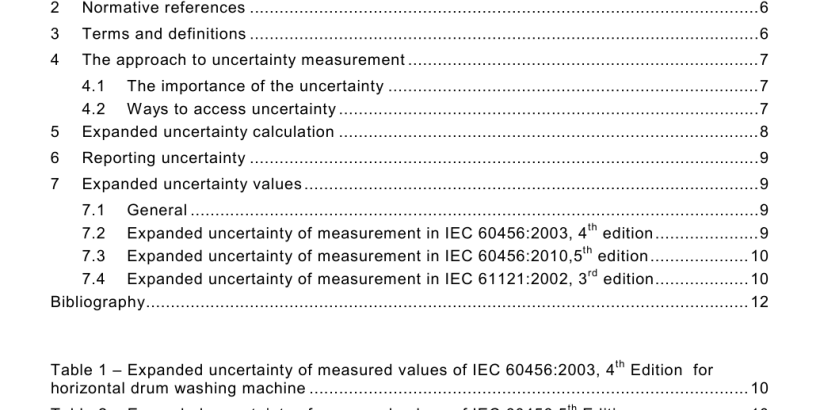IEC TR 62617:2010 pdf download – Home laundry appliances – Uncertainty reporting of measurements
By combining the uncertainties of the input quantities according to the law of propagation of uncertainty (see Clause 2, Guide to the Expression of Uncertainty in Measurement) the uncertainty of the result y can be calculated. With this calculation it can be seen how a specific uncertainty contribution from an input quantity does influence the combined uncertainty of the final result and therefore how a reduction in an uncertainty contribution from an input quantity will influence the combined uncertainty of the final result. Uncertainties may usually be reduced at some cost by making more measurements, using other methods or other equipment.
This means that different approaches can be followed to reduce the uncertainty of the final result in the most cost effective way. b) The top down method (see IEC 61 923) In this method the reproducibility standard deviation is estimated from testing of the same machine (or the same model) in different laboratories using the same measurement method. This testing is in general named ‘ring test’ or ‘round robin test’.
The reproducibility standard deviation of the test results can then be seen as the inherent uncertainty of the measuring method as it may be influenced by remaining differences in the ambient, the people and whatever else may be different between different measurements in different laboratories. In principle it is only valid for the machine investigated in each ring test, but results may be also true for similar types of machines. Therefore the two methods ‘bottom up’ and ‘top down’ may be used in parallel to achieve a reliable uncertainty quantification. But both methods depend on the validity of the model (for the bottom up method) or the data (for the top down method) used.
5 Expanded uncertainty calculation The uncertainty of a measured result has two sources: – the statistical uncertainty of what is measured, as expressed in the repeatability standard deviation, showing the accuracy of the measurement in the laboratory having done the measurement;
– the uncertainty of the measuring method itself. This is expressed as expanded uncertainty where it is common to set the borders at a 95 % confidence interval, which give the minimum and maximum value where the average measured result may be found when the measurement is re-done at any other laboratory. To be meaningful, the uncertainty statement must have an associated confidence level: i.e. it is necessary to state the probability that the true value lies within the range given.
The reasons for choosing a 95 % confidence level in this standard are as follows:
– it is established practice throughout much of Europe, North America and Asia; – the GUM assumes that the combined uncertainty has a distribution that is a close approximation to a normal distribution. A 95 % confidence level approximates to a range of 2 standard deviations. It is a widely held view that, for most measurement systems, the approximation to a normal distribution for the distribution of the combined uncertainty is reliable out to 2 standard deviations, but beyond that the approximation is less reliable. If a normal distribution may be assumed the 95 % confidence interval is given by multiplying the reproducibility standard deviation by a factor of 2.IEC TR 62617 pdf download.
